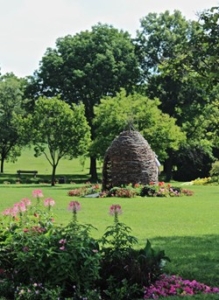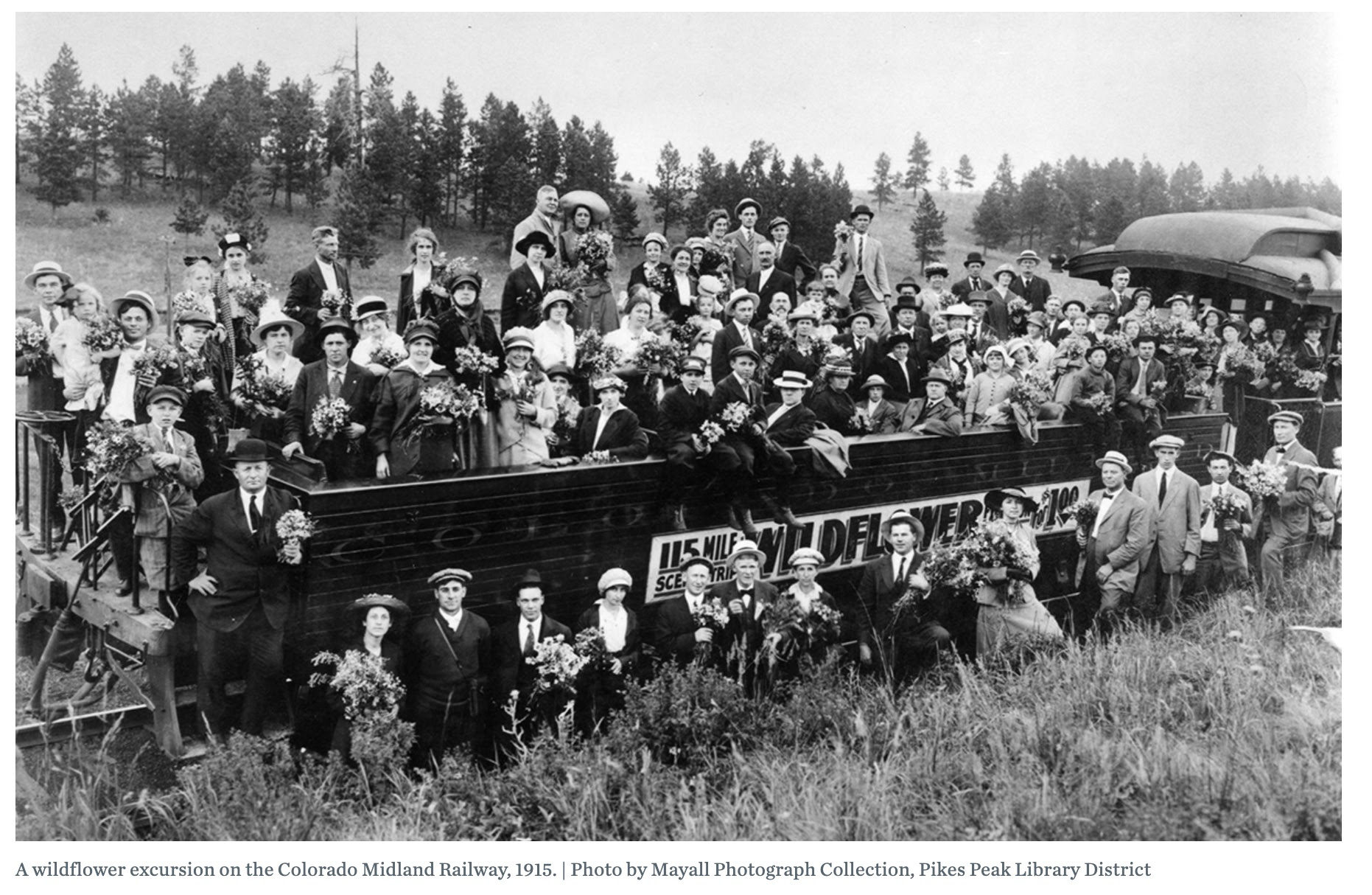An untold story of the female ecologists who pioneered wildflower conservation
By Laura J. Martin, Sierra Magazine
Spring ephemerals have begun to bloom in southern Vermont. The start of wildflower season is more predictable here than in the West, where wildflower emergence follows water, whether snowmelt (early July in Colorado’s Rocky Mountain National Park) or rain (late February in Arizona’s Sonoran Desert). In New England, early May means yellow trout lilies and their stippled leaves. They’ll soon be followed by prim trillium, jocular Dutchman’s breeches, and precise wild columbine.
Perhaps you, too, are a hunter of wildflowers. You crouch down on walks through the woods, looking for the first flash of white, pink, yellow. You visit your local wildflower preserve to spot these short-lived blooms. You buy seedlings for your backyard from a native plant nursery.
Native wildflower gardening is more popular than ever. But a century ago, it was practically unheard of. Wildflowers persist in the numbers they do today because of the activism and research of a group of women ecologists who defied gender norms and founded the discipline of ecological restoration.
The women began with a wildflower boycott. Elizabeth Britton, a renowned expert on mosses and ferns, created the Wild Flower Preservation Society in 1901 in hopes of protecting her favorite botanizing sites just outside Manhattan. She modeled the society after the highly successful Audubon Society, which came together when a group of wealthy Boston women pledged to boycott hats decorated with bird feathers.
Like feathers, wildflowers were fashionable Victorian accessories, adorning hats as well as dining tables. An 1887 magazine article described an elaborate centerpiece made of native wildflowers: a pyramid of jack-in-the-pulpits, violets, and red maple twigs with a border of skunk-cabbage leaves. Britton argued that if women refused to purchase wildflowers from pushcart vendors, it would put an end to harvesting in the countryside, thereby protecting the “victims of the massacre exposed for sale in our city streets.”
The Wild Flower Preservation Society aimed to define moral sensibilities during a time when women’s roles in society were highly contested. In addition to their boycott campaign, WFPS members argued that women could change their behavior in the countryside and stop picking wildflowers. “Let us for a moment consider the cruel waste that is going on in the region of Colorado Springs,” Mary Perle Anderson wrote in 1904. “On certain days in the week special trains run ‘flower-trips’ which are largely patronized by tourists. They recklessly pull up and tear up the flowers, and return with great armfuls and basketfuls, and in their ungoverned enthusiasm, they often deck the cars and festoon the engine with them!”
This “ungoverned enthusiasm” for wildflowers, the WFPS contended, was leading to declines in Christmas greens, ferns, dogwoods, and other species. “Weddings, by the way,” Britton wrote in The New York Times, “are a new menace to our native plants.”
The Wild Flower Protection Society initially aimed to influence the behavior of Anglo-Saxon women, but as the organization expanded, it moved toward policing the behavior of “new immigrants” to the United States. “The gathering of woodland treasures for the city market is largely the work of Italians,” Anderson argued. “With no thought beyond the present need, they are a dangerous foe to plants.” Like other Progressive Era groups, the WFPS strove to assimilate immigrant children through public education. Local chapters developed and distributed educational pamphlets, lantern slides, children’s books, and plays. Wildflower pageants were performed in schools across the country, shaping a generation’s relationship to nature.
The WFPS expanded rapidly during World War I, establishing chapters across the country. Women accounted for most of its membership, with a few men holding leadership roles by invitation. But in 1924, USDA botanist Percy Ricker, a member of the Washington, DC, chapter, began conspiring to take over the WFPS from Britton, claiming that under the leadership of women, wildflower preservation had become a “sentimental” subject and that “professional botanists”—meaning men—had become “disgusted with the over-zealous efforts of individuals and organizations wishing to forbid all flower picking.”
By deriding the work of WFPS leaders as “sentimental,” Ricker channeled a broader postwar campaign to characterize women’s professional and suffrage groups as dangerous. In December 1924, Ricker led a vote to reorganize the WFPS—with himself as president and two male Ecological Society of America members as vice presidents. In a letter to Britton, he described the need of “ladies with such radical ideas” to listen to a “proper presentation of the subject [of wildflower preservation].” Ricker succeeded in his hostile takeover of the WFPS but ultimately failed in his efforts to convince others that ecology was a man’s profession.
Into the 1930s, the WFPS increasingly sought to establish permanent sanctuaries that would be owned by universities or government agencies and managed to promote native plant species. Today one such site, the University of Wisconsin Arboretum’s Curtis Prairie, is often celebrated as the first major ecological restoration site in the United States. One of its designers, Aldo Leopold, is frequently considered the inventor of ecological restoration.
But the Wisconsin Arboretum was neither the only nor the first effort to restore native plant communities—it was just the best publicized. Leopold was embedded in a large network of scientists working to restore native plants. And some of those scientists were women, including Eloise Butler, Edith Roberts, and other ecologists with roots in the WFPS. Their work provided the discipline of ecology with botanical gardens and “outdoor laboratories” to train ecologists and conduct experiments. Their research led to the rise of native plant nurseries and the science of ecological restoration.
The first wildflower garden in the United States was established in 1907 by Eloise Butler, an algae expert and sister of Cora Pease, a well-known naturalist who connected Butler to a community of women scientists that included Elizabeth Britton and Ellen Swallow Richards, the first woman instructor at MIT. Butler and Pease, self-avowed “bog-trotters,” often traveled together on collecting expeditions.
In 1907, Butler organized local science teachers to petition the Minneapolis Park Board for space to establish a botanical garden “to show plants as living things and their adaptations to their environment, to display in miniature the rich and varied flora of Minnesota, and to teach the principles of forestry.” Like the first botanical gardens, which arose in Italian universities in the 16th century, Butler’s project had a pedagogical aim: it would serve as a living reference collection.
But unlike other botanical gardens, Butler’s plants would be organized by environmental requirements, not by evolutionary relationship, use, shape, or color. This was a new type of garden: an ecological one. Butler was influenced by the naturalistic gardening movement, and she favored native species. Naturalistic gardeners opposed non-native plants on aesthetic grounds; they dismissed Old World plants as showy and rejected the straight lines of the Renaissance garden. Moreover, naturalistic gardeners argued that native plants were better adapted to local environmental conditions and therefore required less maintenance.
Butler’s Wild Botanical Garden opened on April 27, 1907, on three acres of tamarack swamp and hillside. From the beginning, Butler viewed the garden as an experimental space. She maintained meticulous records of specimen origins as well as annual survival rates and flowering dates. She developed methods for propagating hundreds of native plant species, many of which were difficult to rear. Orchids were “uncertain, coy and hard to please.” She designed a special water tank to keep Viola lanceolata seedlings moist. To grow saxifrage, she moved a limestone slab from the cliffs of the St. Croix River in Wisconsin to the garden. The garden gradually became a seed and cutting source for amateur and professional ecologists across the country, and other restorationists would learn from her propagation techniques.
On occasion, Butler went to unusual lengths to acquire plants. During an expedition for squirrel corn on the Big Island of Lake Minnetonka, she and Pease dug a hole under a nine-foot-high chicken wire fence. “We kilted our skirts and, weighted with impediments, trudged through the wet grass some three miles across the country,” to emerge “dusty and triumphant!” When Butler was in a train accident in Ontario in 1908, she disembarked and used a broken penknife to collect willow herb. Other plants were sent to Minneapolis by correspondents such as Fannie Mahood Heath, the “flower woman” of North Dakota, a self-taught botanist who grew hundreds of wildflowers on her farm in Grand Forks. Butler once traded 100 maidenhair ferns with a woman in Bemidji, Minnesota, for one clump of the rare ram’s head lady’s slipper. By the end of her life, Butler had planted 710 species at the Wild Botanical Garden, which joined the 400 species already growing on the site.
 Butler curated the Wild Botanical Garden from its founding in 1907 until her death in 1933. Wearing brown overalls and high-laced black leather boots, armed with a broken-off machete and wearing a park watchman’s star pinned to her chest, she would run out the “spooners” who might crush her plants. Tellingly, the Wild Botanic Garden was renamed the Native Plant Reserve in 1929. You can still visit the garden today.
Butler curated the Wild Botanical Garden from its founding in 1907 until her death in 1933. Wearing brown overalls and high-laced black leather boots, armed with a broken-off machete and wearing a park watchman’s star pinned to her chest, she would run out the “spooners” who might crush her plants. Tellingly, the Wild Botanic Garden was renamed the Native Plant Reserve in 1929. You can still visit the garden today.
Whereas Butler designed the Wild Botanic Garden primarily as a reference collection for scientists, Edith Roberts was the first ecologist to design a botanical garden for the express purpose of researching native plant restoration. Roberts was born to farmers in Rollinsford, New Hampshire, in 1881—30 years later than Butler. After attending Smith College, Roberts received a doctorate in botany from the University of Chicago in 1915. During World War I, she worked for the USDA, and afterward she was hired as a professor of botany at Vassar College.
As soon as she arrived at Vassar, Roberts began developing an “Ecological Laboratory.” Her goals were twofold: first, to establish a facility to train students in the new discipline of ecology; and second, to test whether native plants could be reestablished on degraded lands. Beginning in 1921, Roberts and her students cleared over four acres of grasses and poison ivy on the Vassar campus. On the cleared land they planted around 600 species collected from across the country, arranging them into 30 plant communities that Roberts and her students had identified in the area, including the “open field association” and the “bog association.”
Roberts saw the Vassar Ecological Laboratory as a place where ecologists would generate knowledge about the cultivation of native plant species. A number of Roberts’s students went on to complete graduate research on native plant cultivation in universities across the country, and they brought with them the techniques they had learned at the Ecological Laboratory. Opal Davis, for example, discovered that the two-year period of dormancy required to germinate dogwood seeds could be simulated by a 90-day period in a refrigerator.
Work at the Ecological Laboratory led Roberts to collaborate with Elsa Rehmann, a landscape architect who began teaching part-time at Vassar in 1923. Rehmann had studied at the Lowthorpe School of Landscape Architecture for Women in Groton, Massachusetts. Founded in 1901, the Lowthorpe School offered courses to women in surveying, engineering, forestry, and soil science.
A book on naturalistic gardening that Roberts and Rehmann coauthored in 1929, American Plants for American Gardens, would deeply shape the aesthetics and practices of both landscape architecture and restoration ecology. American Plants for American Gardens listed plants by the environmental conditions that promoted their growth, rather than by taxonomy or by geography. It also encouraged the cultivation of native species.
The job of the landscape architect or ecologist, Roberts and Rehmann argued, was to establish the environmental conditions in which native plants could thrive. Gardeners could clear dried underbrush and diseased plants, and they could thin forest cover. They could then plant new trees and herbs. Roberts and Rehmann explained that some species, like milkweeds, thrived in sunny spots. Others, like bellworts, required shade. A wild aesthetic was achievable through constrained, artful human intervention. “It requires no little art to leave the woods absolutely natural and seemingly untouched,” they wrote. “And yet, nature can be aided.”
Today, wildflowers face a number of threats. Global warming caused by greenhouse gas emissions are altering precipitation cycles while causing some species to bloom earlier in the season. This could lead to a mismatch between flowering time and the presence of pollinators, which could prove disastrous for insects and plants alike. Fewer plant species than animal species are protected under the Endangered Species Act, and urban and industrial development continues to threaten locally rare flowers. Across the country, scientists and land managers are working to protect wildflowers from browsing by deer, whose populations have skyrocketed because of the persecution of large predators.
The United Nations recently declared this to be the Decade on Ecosystem Restoration, and governments, corporations, and NGOs have announced massive commitments to ecological restoration. This can make it seem that restoration is a 21st-century phenomenon, and too often those who do consider its history credit men like Aldo Leopold with “inventing” ecological restoration. But restoration’s history is longer most people know. It was Elizabeth Britton, Eloise Butler, Edith Roberts, and other women who developed scientific methods for cultivating native plants and who established the first native plant gardens in the United States.
Laura J. Martin is a historian and ecologist who studies how people shape the habitats of other species. She is the author of Wild by Design: The Rise of Ecological Restoration and articles in journals including Environmental History and Science. Her writing and research have been featured in the New York Times, The Atlantic, The Los Angeles Times, and elsewhere. She is an environmental studies professor at Williams College and a former fellow of the Harvard University Center for the Environment, the Stanford Humanities Center, the American Council of Learned Societies, and the National Science Foundation. She is working on a global history of hormonal herbicides.

